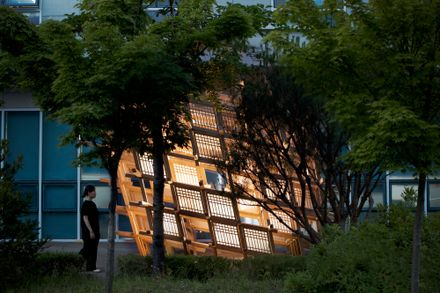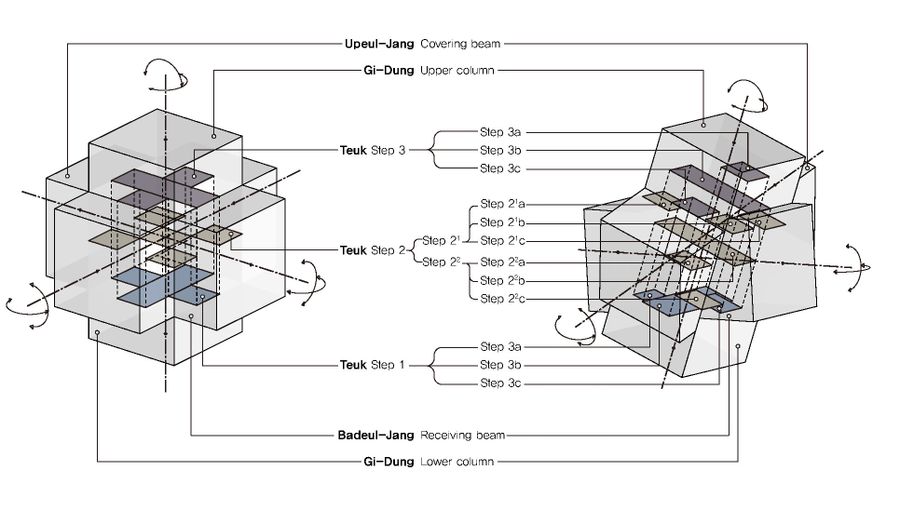
Machum House Pavilion
DESIGN AND FABRICATION
Dachan Oh, Yujin Lee, Rayoung Kim, Seonwoo Lee, Seongmin Hong, Jeongkyun Kwak, Hansol Kang, Jiseon Song, Bada Jeong, Junseo Choi, Jisu Noh, Heeju Jin, Jaehyeok Choi, Dawoon Won
PROGRAM / USE / BUILDING FUNCTION
Public Pavilion
VIDEO EDITING
Yujin Lee
AREA
20 m²
YEAR
2023
LOCATION
South Korea
CATEGORY
Pavilion, Temporary Installations
This project is an architectural experiment employing algorithmic design technology and robotic fabrication, interpreting Sagae-machum, a double cross-lap joinery system in a Korean traditional wooden structure connecting a column and beams (Machum especially means a joint in Korean).
While there has been some recognition and reflection toward the inclusion of traditional forms in modern design, the dominant trend in Korean architecture has been Western-oriented.
However, the advent of advanced robotic technology provides both a new perspective and approach in this field, enhancing productivity and precision.
This experiment suggests a modern construction methodology exploring Sagae-machum, a symbolic element in structural and aesthetical aspects of old craftsmanship in Asian tradition.
Wood has been the primary building material used in Hanok, referred to as a traditional Korean house, with the joinery system serving as a crucial technique for its construction. Sagae-machum is a unique volumetric joint that interlocks a column and beams without any metal fasteners.
The goal of this project is twofold. On one hand, it is to overcome the limitations of efficiency and versatility of traditional Korean joinery systems with cutting-edge technology. It catalyzes research in academia and the architectural industry by referencing the past from a contemporary viewpoint.
On the other hand, using Glued Laminated Timber (GLT), which would be a sustainable alternative to steel acting as structural members, paves the way for green construction by wooden application of the traditional method in an eco-friendly perspective.
To explore Sagae-machum for its contemporary adaptation, a deformed coordinate system of dimension lumber is employed to be manipulated in computational rules.
The lower column and upper column (Gi-Dung) in Z-axis, receiving beam (Badeul-Jang) in Y-axis, covering beam (Upeul-Jang) in the X-axis stack and interlock together forming a set of Sagae-machum module.
Maximizing the contact area between members, Z-axis tilting in 15 degrees experiments structural stability. While the virtual intersecting origin of the 3-perpendicular axis is a point, the deformed origin becomes two to manipulate volumetric elements with interlocking logic.
Three-level steps (Teuk) in the original coordinate branch out into twelve steps inside the tilted Sagae-machum. These steps are designed for keeping the volumetric boolean relationship as well as limiting deformed geometry perpendicular to the wood direction.
These multi-level 3D puzzles also provide tighter assembly between elements, which helps support loads in any direction, behaving as inner bracing. A 6-axis industrial robotic arm (ABB IRB-4600) was used to carve out the boolean-ed members in various heights
The pavilion consists of 239 Sagae-machums assembled by 241 vertical elements and 233 horizontal ones of dimension lumber ranging from 500mm to 1700mm.
These elements interlock with each other as they grow from the ground to a height of 3.7m (seven-module height), and create a gathering space of 5m x 4.2m.
The Korean traditional window frame with translucent paper serves as a medium to allow natural light to enter the space, enabling visitors to interact with the surroundings.
This project aims to expand the possibilities of traditional architecture by leveraging advanced robotic fabrication, enabling the creation of a more versatile and context-based structure.





















